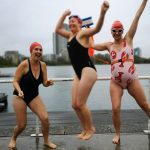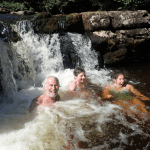The lockdown effect: how swimmers’ behaviours have changed this year
Simon Griffiths wonders if outdoor swimming is like chocolate: he wants more!
I witnessed something remarkable on the first Sunday of “Lockdown Part 2”. It was an unusually warm and pleasant autumn day: sunny, no wind and unseasonably mild at around 17 degrees. Still, this was November in the UK, the days were short and the sun was unable to make much impact on the water temperature in the Thames. A few days previously, this had dropped below 10 degrees and it wasn’t showing any signs of regaining double figures.
The remarkable thing that I witnessed was a steady stream of people, starting at first light and continuing well into the afternoon, getting into the river to swim (and for the record, arriving in ones and twos and maintaining good social distancing to comply with Covid-19 rules). I’d estimate I saw at least 50 swimmers and I wasn’t watching all day. Being curious, I asked a few where they had come from. It soon became clear that swimmers were arriving from across London and beyond, aiming for the first non-tidal stretch of the Thames they could get to. I spoke to people who regularly swam in the Serpentine, Tooting Bec Lido and Parliament Hill Lido. Many, impressively, arrived by bicycle and had travelled considerable distances.
There were more women than men, and a wide range of ages (although skewed towards the more mature), and they had one thing in common: although their regular swimming haunts were closed, they still wanted their cold water swimming fix. And they were prepared to travel an hour or more each way for 10 to 20 minutes in the murky water. This wasn’t about training or fitness but rather sating their desire for a cold plunge. Only a minority pulled on wetsuits, booties and neoprene gloves and attempted anything that looked like fitness swimming.
Lockdown Part 1 happened during the spring and summer. On the hottest days, the river was crowded with pleasure boaters, kayakers, stand up paddle boarders and people messing about on inflatables, including a pink unicorn. There were swimmers too, but easily outnumbered by other water users. On that November Sunday it was the reverse. A couple of paddle boards came by and a lone kayaker or two, but by far the majority of people using the river were swimmers.
How can we explain this? Firstly, it’s a clear indication that winter swimming has become a lot bigger than the bizarre pastime of a few eccentrics. Secondly, swimming in cool water has something – let’s not call it addiction to avoid making light of an awful disease – that inspires people to go to considerable lengths to immerse themselves in it. Thirdly, while many other water-based activities are more enjoyable in warmer conditions, could it be that cold water is where the biggest pleasures of outdoor swimming can be found? This is something I’ve been asking myself. Despite my well-documented and publicly-stated aversion to the cold, I’ve taken a few sub 10-degree dips recently and I’m finding, just like the chocolate I eat afterwards, that I keep going back for more.
Image (c) Julie Hacket







